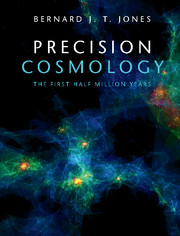Book contents
- Frontmatter
- Dedication
- Contents
- Preface
- Notation and Conventions
- Part I 100 Years of Cosmology
- Part II Newtonian Cosmology
- Part III Relativistic Cosmology
- 10 Minkowski Space
- 11 The Energy Momentum Tensor
- 12 General Relativity
- 13 Space-Time Geometry and Calculus
- 14 The Einstein Field Equations
- 15 Solutions of the Einstein Equations
- 16 The Robertson–Walker Solution
- 17 Congruences, Curvature and Raychaudhuri
- 18 Observing and Measuring the Universe
- Part IV The Physics of Matter and Radiation
- Part V Precision Tools for Precision Cosmology
- Appendix A SI, CGS and Planck Units
- Appendix B Magnitudes and Distances
- Appendix C Representing Vectors and Tensors
- Appendix D The Electromagnetic Field
- Appendix E Statistical Distributions
- Appendix F Functions on a Sphere
- Appendix G Acknowledgements
- References
- Index
10 - Minkowski Space
from Part III - Relativistic Cosmology
Published online by Cambridge University Press: 04 May 2017
- Frontmatter
- Dedication
- Contents
- Preface
- Notation and Conventions
- Part I 100 Years of Cosmology
- Part II Newtonian Cosmology
- Part III Relativistic Cosmology
- 10 Minkowski Space
- 11 The Energy Momentum Tensor
- 12 General Relativity
- 13 Space-Time Geometry and Calculus
- 14 The Einstein Field Equations
- 15 Solutions of the Einstein Equations
- 16 The Robertson–Walker Solution
- 17 Congruences, Curvature and Raychaudhuri
- 18 Observing and Measuring the Universe
- Part IV The Physics of Matter and Radiation
- Part V Precision Tools for Precision Cosmology
- Appendix A SI, CGS and Planck Units
- Appendix B Magnitudes and Distances
- Appendix C Representing Vectors and Tensors
- Appendix D The Electromagnetic Field
- Appendix E Statistical Distributions
- Appendix F Functions on a Sphere
- Appendix G Acknowledgements
- References
- Index
Summary
Inertial frames are fundamental to special relativity, so much so that Einstein was keen to carry them over into his later general theory of relativity, albeit on a merely local basis. This chapter is about inertial frames from the point of view of Minkowski space and Lorentz transformations. After a brief reminder as to what the Lorentz transformation is, we move on to Minkowski's way of thinking by introducing his 4-space, with its 4-vectors and defining metric. We also introduce the covariant and contravariant representation of vectors in these coordinate systems. Once equipped with this we recast Maxwell's equation in our Minkowski space framework, ending with two tensor quantities: the electromagnetic field tensor (also known as the Faraday tensor) and the energy momentum tensor.
Why Relativity?
Limitations of Newtonian Theory
Our Universe, on the largest scales, appears to be homogeneous and isotropic. On those vast scales it is the force of gravity that governs its behaviour. Until the beginning of the 20th century, gravitational phenomena such as the motion of bodies in the Solar System were described in terms of Isaac Newton's theory of gravitation, written down by Newton some 250 years earlier. The successes of Newton's theory were truly remarkable. Not only did it provide an explanation of the orbits of bodies about the Sun, but it also made dramatic predictions that were subsequently verified: the return of Halley's comet and the existence of the planet Neptune. What more could one ask of a theory?
Despite those successes, two problems were evident even during the 19th century. There was the famous problem of the precession of the perihelion of Mercury's orbit about the Sun and there was the problem that Newton's theory could not address the cosmology of the time: a homogeneous and static Universe. Seeliger (1895) modified Newtonian gravity at large distances and his resulting cosmological model was perhaps the best one could do at the time.
However, at the end of 1915, Einstein published the first definitive version of his general theory of relativity, which provided a new theory of gravitation and with that came new cosmological models that could be tested against observations and applied to cosmology.
Throughout the rest of the 20th century numerous tests of Einstein's theory have established its overall validity for describing gravitational phenomena.
Information
- Type
- Chapter
- Information
- Precision CosmologyThe First Half Million Years, pp. 237 - 267Publisher: Cambridge University PressPrint publication year: 2017
